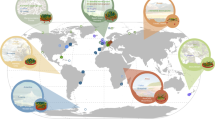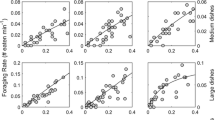Summary
It has been suggested by Cohen and Newman (1985) that many of the patterns in published food webs can be derived from a stochastic model in which the species are arranged in a trophic hierarchy (the ‘cascade model’). We suggest that, if predators are larger than their prey, a trophic hierarchy can be generated on the basis of body size Empirical evidence from the literature shows that there is a positive relationship between predator and prey size for a range of invertebrates and that predators are usually larger than their prey. Using experimental data on an aquatic food web we show that body size can lead to the type of trophic hierarchy used in the cascade model, suggesting that many food web patterns may be a product of body size. This conclusion is discussed with respect to the limitations of the food web data and the relationship between ‘static’ and ‘dynamic’ models of web structure.
Similar content being viewed by others
References
Auerbach MJ (1984) Stability, probability and the topology of food webs. In: Strong DR, Simberloff D, Abele LG, Thistle AB (eds) Ecological Communities, Conceptual Issues and the Evidence, Princetown University Press, Princetown, N.J., pp 413–436
Blois C (1985) The larval diet of three anisopteran (Odonata) species. Freshwater Biol 15:505–514
Briand F, Cohen JE (1984) Community food webs have a scale invariant structure, Nature 307:264–267
Burns CW (1968) The relationship between body sizes of filter feeding Cladocera and maximum size of particles ingested. Limnol Oceanogr 13:675–678
Cohen JE (1978) Food webs and Niche Space. Princetown University Press, Princetown N.J.
Cohen JE, Briand F (1984) Trophic links of community food webs. Proc Natn Acad Sci USA 81:4105–4109
Cohen JE, Newman CM (1985) A stochastic theory of community food webs I. Models and aggregated data. Proc R Soc Lond B 224:421–448
Cohen JE, Newman CM, Briand F (1985) A stochastic theory of community food webs II. Individual webs. Proc R Soc Lond B 224:449–461
Cohen JE, Briand F, Newman CM (1986) A stochastic theory of community food webs III. Predicted and observed lengths of food chains. Proc R Soc Lond B 228:317–353
Cousins SH (1980) A trophic continuum derived from plant structure animal size and a detritus cascade. J Theor Biol 82:607–618
DeAngelis DL, Post WM, Sugihara G (1983) Current Trends in Food Web Theory Report on a Food Web Workshop. Oak Ridge National Laboratory ORNL-5983, Oak Ridge.
Dodson SI (1975) Predation rates of zooplankton in Arctic ponds. Limnol Oceanogr 20:426–433
Elton C (1927) Animal Ecology. Sidgewick and Jackson, London
Enders F (1975) The influence of hunting manner on prey size, particularly in spiders with long attack distances (Araneidae, Linyphiidae and Salticidae). Am Nat 109:737–763
Evans HF (1976) The role of predator-prey size ratio in determining the efficiency of capture by Anthocoris nemorum and the escape reactions of its prey Acyrthosiphon pisum. Ecol Entomol 1:85–90
Feminella JW, Stewart KW (1986) Diet and predation by three leaf associated stoneflies (Plecoptera) in an Arkansas mountain stream. Freshwater Biol 16:521–538
Gittleman JL (1985) Carnivore body size: ecological and taxonomic correlates. Oecologia (Berlin) 67:540–544
Griffiths D (1980) (a) The fecding biology of ant-lion larvae: prey capture, handling and utilisation. J Anim Ecol 49:99–125
Griffiths D (1980) (b) Foraging costs and relative prey size. Am Nat 116:743–752
Harris GP (1985) The answer lies in the nesting behaviour. Freshwater Biol 15:375–380
Hespenheide HA (1973) Ecological inferences from morphological data. Annu Rev Ecol Syst 4:213–229
Hughes RN, Elner RW (1979) Tactics of a predator, Carcinus maenas and morphological responses of the prey Nucella lapillus. J Anim Ecol 48:65–79
Jeffries MJ, Lawton JH, (1985) Predator-prey ratios in communities of freshwater invertebrates: the role of enemy free space. Freshwater Biol 15:105–112
Koslucher DG, Minshall GW (1973) Food habits of some benthic invertebrates in a northern cool desert stream (Deep Creek, Curlew Valley, Idaho-Utah). Trans Amer Microscopical Soc 92:441–452
Lawton JH (1969) Studies on the ecological energetics of damselfly larvae (Odonata: Zygoptera). Unpublished PhD Thesis, University of Durham, England
Li JL, Li HW (1979) Species specific factors affecting predator prey interactions of the copepod Acanthocyclops vernalis with its natural prey. Limnol Oceanogr 24:613–626
Maly EJ (1976) Resource overlaps between co-occuring copepods: effects of predation and environmental fluctuation. Can J Zool 54:933–940
May RM (1973) Stability and complexity in model ecosystems. Princetown University Press, Princetown N.J
May RM (1983) The structure of food webs. Nature 301:566–568
May RM (1986) The search for patterns in the balance of nature: advances and retreats. Ecology 67:1115–1126
McArdle BH, Lawton JH (1979) Effects of prey size and predator instar on the predation of Daphnia by Notonecta. Ecol Entomol 4:267–75
Mithen SJ, Lawton JH (1986) Food web models that generate constant predator-prey ratios. Oecologia (Berlin) 69:542–550
Murtaugh PA (1981) Size selective predation on Daphnia by Neomysis mercedis. Ecology 62:894–900
Nentwig W, Wissel C (1986) A comparison of prey lengths among spiders. Oecologia (Berlin) 68:595–600
Paine RT (1963) Feeding rate of a predaceous gastropod Pleuroploca gigantea Ecology 44:402–403
Paine RT (1976) Size limited predation: an observational and experimental approach with the Mytilus-Piaster interaction. Ecology 57:858–873
Pearson DL, Mury EJ (1979) Character divergence and convergence among tiger beetles (Coleoptera: Cicindelidae). Ecology 60:557–566
Peters RH (1983) The Ecological Implications of Body Size. Cambridge University Press, Cambridge, England
Pimm SL (1982) Food Webs. Chapman and Hall, London, New York
Pimm SL, Lawton JH (1977) The number of trophic levels in ecological communities. Nature 268:329–331
Pimm SL, Lawton JH (1983) Causes of food web structure: dynamics, energy flow and natural history. In: DeAngelis DL, Post WM, Sugihara G (eds) Current Trends in Food Web Theory Report on a Food Web Workshop. Oak Ridge National Laboratory ORNL-5983. Oak Ridge
Polis GA, McCormick SJ (1986) Patterns of resource use and age structure among species of desert scorpion. J Anim Ecol 55:59–73
Pritchard G, Leischner TG (1973) The life history and feeding habits of Sialis cornuta (Ross) in a series of abandoned beaver ponds (Insecta: Megaloptera). Can J Zool 51:121–31
Pyke GH, Pulliam HR, Charnov EL (1977) Optimal foraging: a selective review of theory and tests. Q Rev Biol 52:137–154
Rejmanek M, Stary P (1979) Connectance in real biotic communities and critical values for stability of model ecosystems. Nature 280:311–313
Scott MA, Murdoch WW (1983) Selective predation by the back swimmer Notonecta. Limnology and Oceanography 28:352–366
Sheldon AL (1969) Size relationships of Acroneuria california (Perlidae: Plecoptera) and its prey. Hydrobiologia 34:85–94
Sheldon AL (1980) Resource division by perlid stoneflies (Plecoptera) in a lake outlet ecosystem. Hydrobiologia 71:155–161
Sokal RR, Rohlf FJ (1981) Biometry. Freeman, San Francisco.
Southwood TRE (1985) Insect communities. Antenna 9:108–116
Thompson DJ (1978) Prey size selection by larvae of the damselfly Ischnura elegans. J Anim Ecol 47:769–785
Tsui PTP, Hubbard MD (1979) Feeding habits of the predaceous nymphs of Dolania americana in north-western Florida (Ephemoptera: Behningiidae). Hydrobiologia 67:119–123
Vezina AF (1985) Empirical relationships between predator and prey size among terrestrial vertebrate predators. Oecologia (Berlin) 67:555–565
Wilson DS (1973) Size selective predation among copepods. Ecology 54:909–914
Yodzis P (1980) The connectance of real ecosystems. Nature 284:544–5
Young AM (1967) Predation in the larvae of Dytiscus marginalis L.(Coleoptera: Dytiscidae). Pan Pacific Entomologist 43:113–117
Author information
Authors and Affiliations
Rights and permissions
About this article
Cite this article
Warren, P.H., Lawton, J.H. Invertebrate predator-prey body size relationships: an explanation for upper triangular food webs and patterns in food web structure?. Oecologia 74, 231–235 (1987). https://doi.org/10.1007/BF00379364
Received:
Issue Date:
DOI: https://doi.org/10.1007/BF00379364




